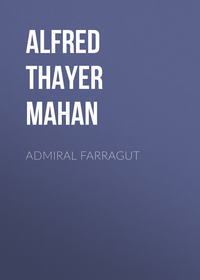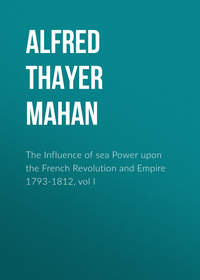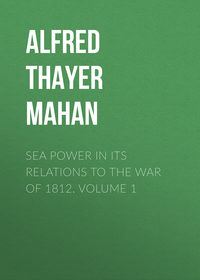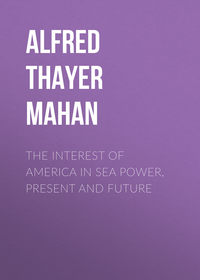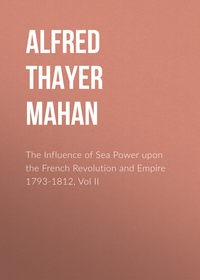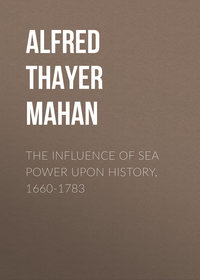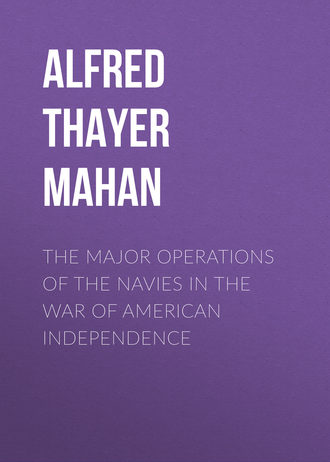 полная версия
полная версияThe Major Operations of the Navies in the War of American Independence
The captain of the Janus died a natural death during the encounter. It may be interesting to note that the ship was given to Nelson, who was recalled for that purpose from the expedition to San Juan, Nicaragua, one of the minor operations of the war. His health, however, prevented this command from being more than nominal, and not long afterward he returned to England with Cornwallis, in the Lion.
Three months later, Cornwallis was sent by Parker to accompany a body of merchant ships for England as far as the neighborhood of Bermuda. This duty being fulfilled, he was returning toward his station, having with him two 74's, two 64's, and one 50, when, on the morning of June 20, a number of sail were seen from north-east to east (a); the British squadron (aa) then steering east, with the wind at south-south-east. The strangers were a body of French transports, carrying the six thousand troops destined for Rhode Island, and convoyed by a division of seven ships of the line—one 80, two 74's, and four 64's—under the command of Commodore de Ternay. Two of the ships of war were with the convoy, the other five very properly to windward of it. The latter therefore stood on, across the bows of the British, to rejoin their consorts, and then all hauled their wind to the south-west, standing in column (bb) towards the enemy. Cornwallis on his part had kept on (b) to reconnoitre the force opposed to him; but one of his ships, the Ruby, 64, was so far to leeward (b') that the French, by keeping near the wind, could pass between her and her squadron (b, b, b'). She therefore went about (t) and steered southwest, on the port tack (c'), close to the wind. The French, who were already heading the same way, were thus brought on her weather quarter in chase. Cornwallis then wore his division (w), formed line of battle on the same tack as the others (c), and edged down towards the Ruby. If the French now kept their wind, either the Ruby (c') must be cut off, or Cornwallis, to save her, must fight the large odds against him. De Ternay, however, did not keep his wind but bore up,—yielded ground (cc). "The enemy," wrote Cornwallis, "kept edging off and forming line, though within gunshot. At 5.30 P.M., seeing we had pushed the French ships to leeward sufficiently to enable the Ruby, on our lee bow, to join us, I made the signal to tack." As the British squadron went about to stand east again (d), the French, heading now west-south-west (cc), hoisted their colours and opened fire in passing. The Ruby kept on till she fetched the wake of the British column (d'), when she too tacked. The French then tacked also, in succession (d), and the two columns stood on for awhile in parallel lines, exchanging shots at long range, the British to windward. Cornwallis very properly declined further engagement with so superior a force. He had already done much in saving a ship so greatly exposed.
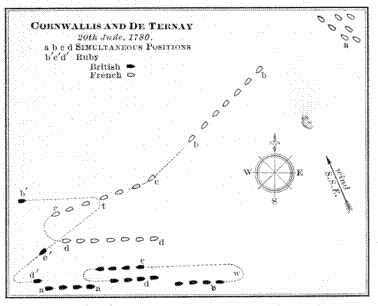
Cornwallis and De Ternay, June 20, 1780
The account above followed is that of the British commander, but it does not differ in essentials from the French, whose captains were greatly incensed at the cautious action of their chief. A French commissaire in the squadron, who afterwards published his journal, tells that de Ternay a few days later asked the captain of one of the ships what English admiral he thought they had engaged, and received the reply, "We have lost our opportunity of finding out." He gives also many details of the talk that went on in the ships, which need not be repeated. Chevalier points out correctly, however, that de Ternay had to consider that an equal or even a superior force might be encountered as Narragansett Bay was approached, and that he should not risk crippling his squadron for such a contingency. The charge of six thousand troops, under the then conditions, was no light responsibility, and at the least must silence off-hand criticism now. Comment upon his action does not belong to British naval history, to which the firmness and seamanship of Captain Cornwallis added a lasting glory. It may be noted that fifteen years later, in the French Revolution, the same officer, then a Vice-Admiral, again distinguished himself by his bearing in face of great odds, bringing five ships safe off, out of the jaws of a dozen. It illustrates how luck seems in many cases to characterise a man's personality, much as temperament does. Cornwallis, familiarly known as "Billy Blue" to the seamen of his day, never won a victory, nor had a chance of winning one; but in command both of ships and of divisions, he repeatedly distinguished himself by successfully facing odds which he could not overcome.
The year 1780 was uneventful also in European waters, after Rodney's relief of Gibraltar in January. The detachment of the Channel Fleet which accompanied him on that mission returned safely to England. The "Grand Fleet," as it still was styled occasionally, cruised at sea from June 8th to August 18th, an imposing force of thirty-one ships of the line, eleven of them three-deckers of 90 guns and upwards. Admiral Francis Geary was then Commander-in-Chief, but, his health failing, and Barrington refusing to take the position, through professed distrust of himself and actual distrust of the Admiralty, Vice-Admiral George Darby succeeded to it, and held it during the year 1781.
The most notable maritime event in 1780 in Europe was the capture on August 9th of a large British convoy, two or three hundred miles west of Cape St. Vincent, by the allied fleets from Cadiz. As out of sixty-three sail only eight escaped, and as of those taken sixteen were carrying troops and supplies necessary for the West India garrisons, such a disaster claims mention among the greater operations of war, the success of which it could not fail to influence. Captain John Moutray, the officer commanding the convoy, was brought to trial and dismissed his ship; but there were not wanting those who charged the misadventure to the Admiralty, and saw in the captain a victim. It was the greatest single blow that British commerce had received in war during the memory of men then living, and "a general inclination prevailed to lay the blame upon some individual, who might be punished according to the magnitude of the object, rather than in proportion to his demerit."89
During the year 1780 was formed the League of the Baltic Powers, known historically as the Armed Neutrality, to exact from Great Britain the concession of certain points thought essential to neutral interests. The accession of Holland to this combination, together with other motives of dissatisfaction, caused Great Britain to declare war against the United Provinces on the 20th of December. Orders were at once sent to the East and West Indies to seize Dutch possessions and ships, but these did not issue in action until the following year.
Towards the end of 1780 the French Government, dissatisfied with the lack of results from the immense combined force assembled in Cadiz during the summer months, decided to recall its ships, and to refit them during the winter for the more extensive and aggressive movements planned for the campaign of 1781. D'Estaing was sent from France for the purpose; and under his command thirty-eight ships of the line, in which were included those brought by de Guichen from the West Indies, sailed on the 7th of November for Brest. Extraordinary as it may seem, this fleet did not reach its port until the 3d of January, 1781.
CHAPTER IX
NAVAL CAMPAIGN IN WEST INDIES IN 1781. CAPTURE OF ST. EUSTATIUS BY RODNEY. DE GRASSE ARRIVES IN PLACE OF DE GUICHEN. TOBAGO SURRENDERS TO DE GRASSE
Rodney, returning to the West Indies from New York, reached Barbados on December 6th, 1780. There he seems first to have learned of the disastrous effects of the great October hurricanes of that year. Not only had several ships—among them two of the line—been wrecked, with the loss of almost all on board, but the greater part of those which survived had been dismasted, wholly or in part, as well as injured in the hull. There were in the West Indies no docking facilities; under-water damage could be repaired only by careening or heaving-down. Furthermore, as Barbados, Santa Lucia, and Jamaica, all had been swept, their supplies were mainly destroyed. Antigua, it is true, had escaped, the hurricane passing south of St. Kitts; but Rodney wrote home that no stores for refitting were obtainable in the Caribbee Islands. He was hoping then that Sir Peter Parker might supply his needs in part; for when writing from Santa Lucia on December 10th, two months after the storm, he was still ignorant that the Jamaica Station had suffered to the full as severely as the eastern islands. The fact shows not merely the ordinary slowness of communications in those days, but also the paralysis that fell upon all movements in consequence of that great disaster. "The most beautiful island in the world," he said of Barbados, "has the appearance of a country laid waste by fire and sword."
Hearing that the fortifications at St. Vincent had been almost destroyed by the hurricane, Rodney, in combination with General Vaughan, commanding the troops on the station, made an attempt to reconquer the island, landing there on December 15th; but the intelligence proved erroneous, and the fleet returned to Santa Lucia. "I have only nine sail of the line now with me capable of going to sea," wrote the Admiral on the 22d, "and not one of them has spare rigging or sails." In the course of January, 1781, he was joined by a division of eight ships of the line from England, under the command of Rear-Admiral Sir Samuel Hood,—Nelson's Lord Hood. These, with four others refitted during that month, not improbably from stores brought in Hood's convoy of over a hundred sail, raised the disposable force to twenty-one ships of the line: two 90's, one 80, fifteen 74's, and three 64's.
On the 27th of January, an express arrived from England, directing the seizure of the Dutch possessions in the Caribbean, and specifying, as first to be attacked, St. Eustatius and St. Martin, two small islands lying within fifty miles north of the British St. Kitts. St. Eustatius, a rocky patch six miles in length by three in breadth, had been conspicuous, since the war began, as a great trade centre, where supplies of all kinds were gathered under the protection of its neutral flag, to be distributed afterwards in the belligerent islands and the North American continent. The British, owing to their extensive commerce and maritime aptitudes, derived from such an intermediary much less benefit than their enemies; and the island had been jealously regarded by Rodney for some time. He asserted that when de Guichen's fleet could not regain Fort Royal, because of its injuries received in the action of April 17th, it was refitted to meet him by mechanics and materials sent from St. Eustatius. On the other hand, when cordage was to be bought for the British vessels after the hurricanes of 1780, the merchants of the island, he said, alleged that there was none there; although, when he took the island soon afterwards, many hundred tons were found that had been long in stock.
Rodney and Vaughan moved promptly. Three days after their orders arrived, they sailed for St. Eustatius. There being in Fort Royal four French ships of the line, six British were left to check them, and on the 3d of February the fleet reached its destination. A peremptory summons from the commander of a dozen ships of the line secured immediate submission. Over a hundred and fifty merchant ships were taken; and a convoy of thirty sail, which had left the island two days before, was pursued and brought back. The merchandise found was valued at over £3,000,000. The neighbouring islands of St. Martin and Saba were seized also at this time.
Rodney's imagination, as is shown in his letters, was greatly impressed by the magnitude of the prize and by the defenceless condition of his capture. He alleged these as the motives for staying in person at St. Eustatius, to settle the complicated tangle of neutral and belligerent rights in the property involved, and to provide against the enemy's again possessing himself of a place now so equipped for transactions harmful to Great Britain. The storehouses and conveniences provided for the particular traffic, if not properly guarded, were like fortifications insufficiently garrisoned. If they passed into the hands of the enemy, they became sources of injury. The illicit trade could start again at once in full force, with means which elsewhere would have first to be created. There were a mile and a half of storehouses in the lower town, he said, and these he must leave at the least roofless, if not wholly demolished.
For such reasons he remained at St. Eustatius throughout February, March, and April. The amount of money involved, and the arbitrary methods pursued by him and by Vaughan, gave rise to much scandal, which was not diminished by the King's relinquishing all the booty to the captors, nor by the latters' professed disinterestedness. Men thought they did protest too much. Meanwhile, other matters arose to claim attention. A week after the capture, a vessel arrived from the Bay of Biscay announcing that eight or ten French sail of the line, with a large convoy, had been seen on the 31st of December steering for the West Indies. Rodney at once detached Sir Samuel Hood with eleven ships of the line, directing him to take also under his command the six left before Fort Royal, and to cruise with them to windward of Martinique, to intercept the force reported. Hood sailed February 12th. The particular intelligence proved afterwards to be false, but Hood was continued on his duty. A month later he was ordered to move from the windward to the leeward side of the island, and to blockade Fort Royal closely. Against this change he remonstrated, and the event showed him to be right; but Rodney insisted, saying that from his experience he knew that a fleet could remain off Fort Royal for months without dropping to leeward, and that there ships detached to Santa Lucia, for water and refreshments, could rejoin before an enemy's fleet, discovered to windward, could come up. Hood thought the Admiral's object was merely to shelter his own doings at St. Eustatius; and he considered the blockade of Fort Royal to be futile, if no descent upon the island were intended. "It would doubtless have been fortunate for the public," he remarked afterwards, "had Sir George been with his fleet, as I am confident he would have been to windward instead of to leeward, when de Grasse made his approach."
The preparations of the French in Brest were completed towards the end of March, and on the 22d of that month Rear-Admiral de Grasse sailed, having a large convoy under the protection of twenty-six ships of the line. A week later six of the latter parted company, five under Suffren for the East Indies and one for North America. The remaining twenty continued their course for Martinique, which was sighted on the 28th of April. Before sunset, Hood's squadron also was discovered to leeward of the island, as ordered by Rodney to cruise, and off the southern point,—Pointe des Salines. De Grasse then hove-to for the night, but sent an officer ashore both to give and to obtain intelligence, and to reach an understanding for concerted action next day.
The French fleet consisted of one ship of 110 guns, three 80's, fifteen 74's, and one 64, in all 20 of the line, besides three armed en flûte,90 which need not be taken into account, although they served to cover the convoy. Besides these there were the four in Fort Royal, one 74 and three 64's, a junction of which with the approaching enemy it was one of Hood's objects to prevent. The force of the British was one 90, one 80, twelve 74's, one 70, and two 64's: total, 17. Thus both in numbers and in rates of ships Hood was inferior to the main body alone of the French; but he had the advantage of ships all coppered, owing to Rodney's insistence with the Admiralty. He also had no convoy to worry him; but he was to leeward.
Early in the morning of the 29th, de Grasse advanced to round the southern point of the island, which was the usual course for sailing ships. Hood was too far to leeward to intercept this movement, for which he was blamed by Rodney, who claimed that the night had not been properly utilised by beating to windward of Pointe des Salines.91 Hood, on the other hand, said in a private letter: "I never once lost sight of getting to windward, but it was totally impossible.... Had I fortunately been there, I must have brought the enemy to close action upon more equal terms, or they must have given up their transports, trade, etc." Hood's subsequent career places it beyond doubt that had he been to windward there would have been a severe action, whatever the result; but it is not possible to decide positively between his statement and Rodney's, as to where the fault of being to leeward lay. The writer believes that Hood would have been to windward, if in any way possible. It must be added that the British had no word that so great a force was coming. On this point Hood and Rodney are agreed.
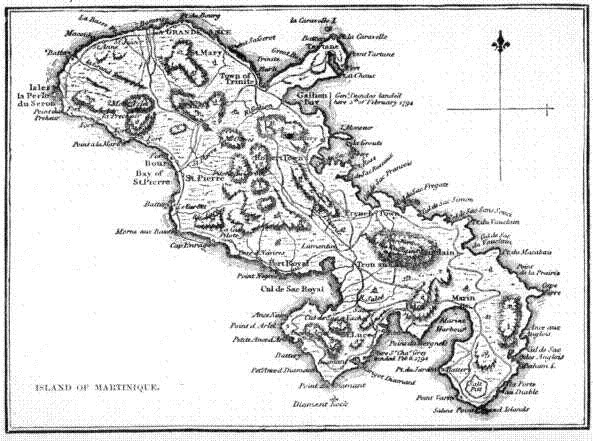
Island of Martinique
Under the conditions, the French passed without difficulty round Pointe des Salines, the transports hugging the coast, the ships of war being outside and to leeward of them. Thus they headed up to the northward for Fort Royal Bay (Cul de Sac Royal), Hood standing to the southward until after 10, and being joined at 9.20 by a sixty-four (not reckoned in the list above) from Santa Lucia, making his force eighteen. At 10.35 the British tacked together to the northward. The two fleets were now steering the same way, the French van abreast of the British centre. At 11 the French opened their fire, to which no reply was made then. At 11.20, the British van being close in with the shore to the northward of the Bay, Hood tacked again together, and the enemy, seeing his convoy secure, wore, also together, which brought the two lines nearer, heading south. At this time the four French ships in the Bay got under way and easily joined the rear of their fleet, it having the weather-gage. The French were thus 24 to 18. As their shot were passing over the British, the latter now began to reply. At noon Hood, finding that he could not close the enemy, shortened sail to topsails and hove-to, hoping by this defiance to bring them down to him. At 12.30 the French admiral was abreast of the British flagship, and the action became general, but at too long range. "Never, I believe," wrote Hood, "was more powder and shot thrown away in one day before." The French continuing to stand on, Hood filled his sails again at 1 P.M., as their van had stretched beyond his.
As the leading ships, heading south, opened the channel between Santa Lucia and Martinique, they got the breeze fresher, which caused them to draw away from the centre. Hood, therefore, at 1.34 made the signal for a close order, and immediately afterwards ceased firing, finding not one in ten of the enemy's shot to reach. The engagement, however, continued somewhat longer between the southern—van—ships, where, by the account of Captain Sutherland, who was in that part of the line, four of the British were attacked very smartly by eight of the French. The Centaur, Russell, Intrepid, and Shrewsbury appear to have been the ships that suffered most heavily, either in hull, spars, or crews. They were all in the van on the southern tack. The Russell, having several shot between wind and water, was with difficulty kept afloat, the water rising over the platform of the magazine. Hood sent her off at nightfall to St. Eustatius, where she arrived on the 4th of May, bringing Rodney the first news of the action, and of the numbers of the French reinforcement. During the 30th Hood held his ground, still endeavouring to get to windward of the enemy; but failing in that attempt, and finding two of his squadron much disabled, he decided at sunset to bear away to the northward, because to the southward the westerly currents set so strong that the crippled ships could not regain Santa Lucia. On the 11th of May, between St. Kitts and Antigua, he joined Rodney, who, after hurried repairs to the Russell, had left St. Eustatius on the 5th, with that ship, the Sandwich, and the Triumph.
It is somewhat difficult to criticise positively the conduct of Hood and of de Grasse in this affair. It is clear that Hood on the first day seriously sought action, though his force was but three-fourths that of his foe. He tried first to take the offensive, and, failing that, to induce his enemy to attack frankly and decisively. Troude is doubtless correct in saying that it was optional with de Grasse to bring on a general engagement; and the writer finds himself in agreement also with another French authority, Captain Chevalier, that "Count de Grasse seems to have been too much preoccupied with the safety of his convoy on the 29th, Admiral Hood having shown himself much less circumspect on that day than he was on the next. Notwithstanding our numerical superiority, Count de Grasse kept near the land until all the convoy were safe." He represents Hood as fencing cautiously on the following day, keeping on the field, but avoiding a decisive encounter. This differs somewhat from the version of Hood himself, who mentions signalling a general chase to windward at 12.30 P.M. of the 30th. The two statements are not irreconcilable. Hood having coppered ships, had the speed of the French, whose vessels, being partly coppered and partly not, sailed unevenly. The British commander consequently could afford to take risks, and he therefore played with the enemy, watching for a chance. Hood was an officer of exceptional capacity, much in advance of his time. He thoroughly understood a watching game, and that an opportunity might offer to seize an advantage over part of the enemy, if the eagerness of pursuit, or any mishap, caused the French to separate. From any dilemma that ensued, the reserve of speed gave him a power of withdrawal, in relying upon which he was right. The present writer adopts here also Chevalier's conclusion: "Admiral Hood evidently had the very great advantage over his enemy of commanding a squadron of coppered ships. Nevertheless, homage is due to his skill and to the confidence shown by him in his captains. If some of his ships had dropped behind through injuries received, he would have had to sacrifice them, or to fight a superior force." This means that Hood for an adequate gain ran a great risk; that he thoroughly understood both the advantages and the disadvantages of his situation; and that he acted not only with great skill, but warily and boldly,—a rare combination. The British loss in this affair was 39 killed, including Captain Nott, of the Centaur, and 162 wounded. The French loss is given by Chevalier as 18 killed and 56 wounded; by Beatson, as 119 killed and 150 wounded.
Rodney, having collected his fleet, proceeded south, and on the 18th of May put into Barbados for water. Much anxiety had been felt at first for Santa Lucia, which Hood's retreat had uncovered. As was feared, the French had attacked it at once, their fleet, with the exception of one or two ships, going there, and twelve hundred troops landing at Gros Ilet Bay; but the batteries on Pigeon Island, which Rodney had erected and manned, kept them at arms' length. The works elsewhere being found too strong, the attempt was abandoned.
At the same time, two French ships of the line and thirteen hundred troops had sailed from Martinique against Tobago. When de Grasse returned from the failure at Santa Lucia, he learned that the British were at sea, apparently bound for Barbados. Alarmed for his detachment before Tobago, he again sailed with the fleet for that island on the 25th of May, accompanied by three thousand more troops. Rodney learned at Barbados of the attempt on Tobago, and on the 29th dispatched a squadron of six sail of the line, under Rear-Admiral Francis Samuel Drake, to support the defence. On the 30th he heard that the French main fleet had been seen to windward of Santa Lucia, steering south, evidently for Tobago. On the same day Drake and de Grasse encountered one another off the latter island, the French being to leeward, nearest the land. Drake necessarily retired, and on the morning of June 3d was again off Barbados, whereupon Rodney at once sailed for Tobago with the whole fleet. On the 4th the island was sighted, and next morning information was received that it had capitulated on the 2d.



